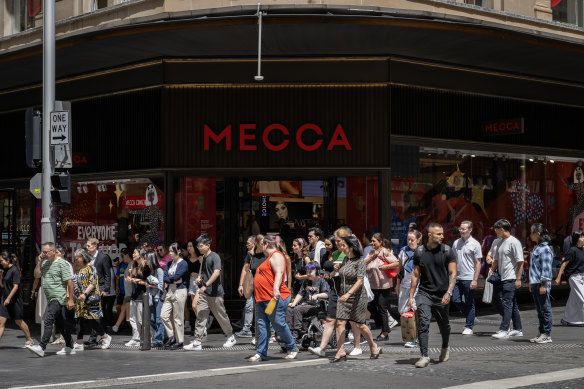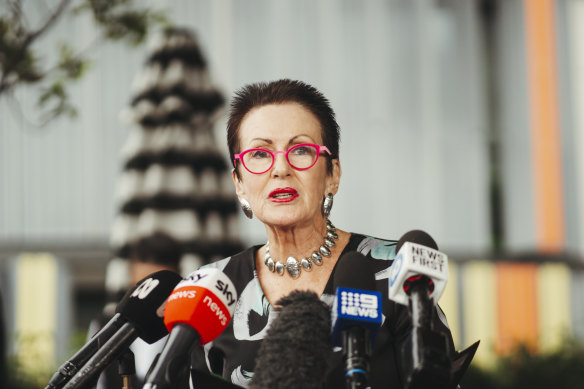Driving in central Sydney will become harder under a plan to make the city more comfortable for pedestrians.
The City of Sydney wants to narrow roads for wider footpaths and push for lower speed limits to discourage drivers from the CBD and transform Sydney into a walkable city.
The council will also install more pedestrian crossings and prioritise people over cars at signals amid warnings driving motorists out of the city will cause economic damage.

Pedestrians outnumber drivers in much of central Sydney, but cars still dominate the roads. Credit: Louie Douvis
The council’s draft walking strategy, which is open for public feedback until April 5, states that there are five times more pedestrians than motorists on the average street, yet just 40 per cent of road space is allocated to footpaths.
With daily visitors to central Sydney forecast to rise from 1.2 million to 2 million by 2050, the strategy says more efficient modes of transport are required.
“When more people walk, ride or catch public transport instead of driving, valuable road space is freed up for those who need to drive, like tradespeople, delivery drivers and emergency service vehicles,” the strategy says.
Lord Mayor Clover Moore said the council was spending $28 million a year to make Sydney more walkable and transform it into a “greener, safer, calmer city”.

Sydney needs fewer cars and more walking options says Lord Mayor Clover Moore.Credit: Dion Georgopoulos
“Walkable cities attract businesses, workers and visitors, driving economic growth,” she said.
Moore said installing light rail on George Street was an example of how the city could become less vehicle-dependent.
“The conga lines of buses on the traffic-clogged, noisy, dirty street have been replaced by a beautiful tree-lined pedestrian boulevard through the heart of our city,” she said.
However, the installation of bike lanes on CBD streets has been controversial, while the reduction of traffic lanes on Oxford Street for a cycleway and wider footpaths has also provoked opposition from some business owners and motorists.
“Drivers in Sydney, particularly the high-testosterone 28-year-old male road kings in Ford Raptors, really need to relax”
Lyndon Gannon, Liberal councillor
Business Sydney executive director Paul Nicolaou welcomed efforts to make the city pedestrian-friendly, but he said the council had limited powers and warned of the economic repercussions of discouraging motorists.
“In taking a broader view, Council would see that Sydney is fundamentally a vibrant commercial city and, as such, motor vehicles, private and commercial, will remain part of its day-to-day and nightly activity,” he said.
But Nicolaou said it was difficult to see how making Sydney a predominantly walking city would benefit businesses such as retailers.
“With sensible management, alternative ways of getting around the city can be catered for, while ensuring the commercial life of the city is supported and able to function efficiently,” he said.
More than one-third of central Sydney households do not own a car, which is much higher than the 11 per cent overall across Greater Sydney.
Liberal councillor Lyndon Gannon said increasing walkability was a fine ambition, “but we must get the balance right and plan ahead”.
“The city isn’t just for locals, it is where much of the Australian economy is driven,” Gannon said.
Gannon said the transformation of George Street was fantastic, “but we can’t do that to every street. Businesses need loading zones, postmen need mail zones, and people need to move about.”
A regular cyclist and motorcycle rider, Gannon said he backed the slowing down of traffic.
“I really do want to see streets slowed down. Drivers in Sydney, particularly the high-testosterone 28-year-old male road kings in Ford Raptors, really need to relax,” he said.
The walking strategy is backed by pedestrian lobby group WalkSydney, whose president Marc Lane said the city “would be a lot better starting with a policy of fewer noisy, polluting vehicles”.
Lane said a street filled with pedestrians was a greater economic resource than a high street choked with traffic.
“Having spent billions on a massive motorway network to bypass the city, now is the time to start removing cars from city streets that these tunnels replace and reprioritising space for people to walk,” he said.
WalkSydney also wants the council to push harder on lowering the speed limit to 30 km/h and wants action on issues such as traffic light timing under the control of the state government.
Lane said the council’s efforts to make streets more pedestrian-friendly were also undermined by traffic signals that do not prioritise walkers, state government roads that are dangerous to cross due to lack of crossings or excessive speed limits, and “urban highways” through central Sydney.